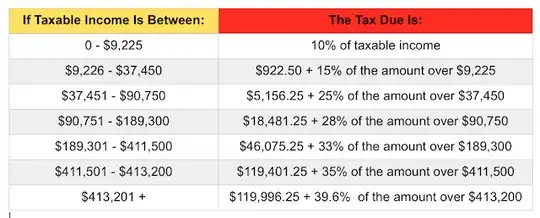H.R. basically consults Publication 15 (this is the link to 2015) to determine how much to hold, based on filing status, exemptions, and pay amount. What's described here is a form of estimation, or, in other words, H.R. withholds what would be your actual taxes, dividing across the number of paychecks you receive. Assuming your gross pay and exemptions do not change, this usually results in a zero-sum for taxes owed (you will receive nothing, and owe nothing).
As you can see from the charts, the year is basically broken down into equal tax units that reflect how much you would owe if you worked at that bracket all year. This estimation works best when you have steady hours from check to check. In other words, your taxes are based on the estimate of what you'd make if you earned that much all year, scaled down to the time frame (e.g. 1/52 if you are paid weekly, or 1/26 if you paid biweekly). They do not go "up" near the end of the year, because they're estimated in advance. You don't move up a tax bracket, but are instead taxed at a particular bracket every paycheck.
There's also other forms of estimation mentioned there, but basically follow the same scheme. Note that all estimation forms are just that-- estimates. It's best to use a calculator and compare your current taxes whenever a significant change occurs-- a raise, a new child, getting married or divorced, etc. You'll want to be able to alter your exemptions so that enough taxes are coming out. That's also the reason for the "withhold extra" box, so that you can avoid owing.
For example, if you're making $44 a week for the first 26 weeks, and then you make $764 a week for the second 26 weeks of the year, you'll end up with an actual tax liability of $2,576.6, but end up paying only $2,345.20. You would owe $231.40. Of course, the actual math is a lot more complicated if you're an employee paid by the minute, for example, or you have a child, go to college, etc.
Paychecks that vary wildly, like $10,000 one week and $2,000 the next tend to have the hardest-to-predict estimates (e.g. jobs with big commission payouts). You should avoid living check-to-check with jobs that pay this way, because you'll probably end up owing taxes. Conversely, if you've done your estimates right and you're paid salary or exactly the same number of hours every week, you'll find that the taxes are much easier to predict and you can usually easily create a refund situation simply by having the correct exemptions on your check.
So, in summation, if your check falls in the 25% category (which is, of course, 25% above the tax bracket break point), you're already paying the correct amount, and no further drop in your check would be expected.
